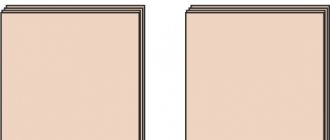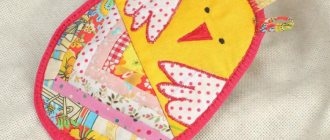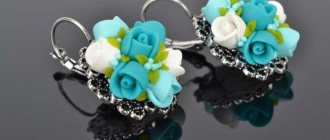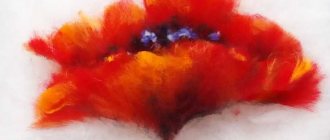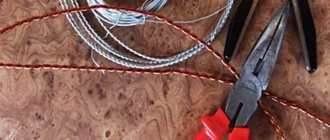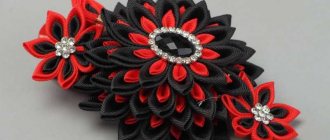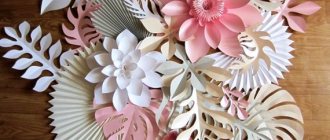Flowers made of nylon
Flower nylon is perfect for creating delicate sweet peas. The transparency of the nylon will only emphasize the fragility of this flower. Sweet peas will look very beautiful in a floral arrangement, but no less impressive will be their use in the form of jewelry: hairpins, headbands, brooches, etc.
Another popular spring flower is, of course, the lily of the valley. Today you can learn how to make lily of the valley flowers from nylon with your own hands. Flowers can be used both for a bouquet and as an element of various decorative compositions. For example, on March 8th or Easter.
A bouquet of tulips in just a month will be very relevant: before we even have time to blink an eye, spring will come and March 8th. Let's start preparing early! Today we offer to learn how to make flowers from nylon and wire in stages.
Orchid primrose attracts attention thanks to its unusual inflorescences in the form of spikelets, on which small flowers gradually bloom from bottom to top.
The charming and delicate gardenia is prized for its luxurious white flowers.
A distant relative of the banana, heliconia, can grow up to 3 meters in height. Due to its bright and eye-catching colors, this spectacular plant is often called the “parrot flower.”
The flame lily or gloriosa is rightfully considered one of the most beautiful representatives of the lilies. Recently, Gloriosa has become a popular ornamental plant that many gardeners dream of adding to their collection. But we are lucky - we have gold handles and we will make a fiery lily from nylon!
Amazing hydrangea is a small shrub or tree. Hydrangea flowers are very decorative, they can be of different shades: white, blue, lilac and purple, which gives a lot of scope for those who want to make hydrangea flowers with their own hands from nylon.
Gerbera is a simple flower, but its simplicity does not prevent it from being one of the most popular flowers among florists. Surely you either gave or received a bouquet containing gerberas.
www.mastera-rukodeliya.ru
Flowers made of nylon: a detailed master class :: SYL.ru
Flowers have always been considered the best decoration for the home. However, they have a huge drawback - they wither too quickly, and even the most luxurious bouquet has to be thrown away after 6-7 days. That is why at all times craftsmen have strived to create a rose, tulip, daffodil, chrysanthemum, etc. from paper, fabric, plastic, wax. Everyone remembers the fairy tale about how Danila the craftsman made a magically beautiful flower from such a seemingly unsuitable material as malachite.
And today there is no shortage of craftsmen who can create beauty from anything, even from old nylon tights. Moreover, bouquets made from this type of textile are often simply indistinguishable from the real thing and even more beautiful. That is why there are always many people who want to learn how to make flowers from nylon.
What will you need?
To make such delicate and beautiful crafts, first of all, you will need nylon. Of course, you can take the top of your or your daughter’s stockings or tights, since children’s models are brighter and you can find an option in the desired color. In addition, specialized stores today sell skeins of nylon for crafts 50-80 cm long (both plain and with smooth or contrasting color transitions and patterns).
To make flowers from nylon, you also need to purchase 2 types of wire:
- rigid floristic, used for making stems;
- flexible, different colors, designed to create a frame of petals.
The first type of wire, in turn, comes with a plastic or paper coating. Typically, its standard length ranges from 30 to 80 cm. As for flexible, it is sold by the meter, and there are options of different thicknesses, with numbers from 18 to 30.
You also need to get templates with a diameter of 1.7 to 7.5 cm. If they are not sold in your city, you can glue such cylinders yourself from a sheet of fairly thick, but easily bendable cardboard.
In addition, to make flowers from nylon with your own hands, you will need green tape, with which the parts will be fastened together and the stems will be shaped.
Additional accessories and tools
In order for the flowers to turn out as similar to real ones as possible, it is also worth purchasing ready-made stamens and pistils made of plastic. It will be ideal if you can also find ready-made sepals and leaves.
As for what tools you will need to make flowers from nylon, their set is quite simple. These are round nose pliers, pliers, scissors. You will also need cotton wool, threads to match the color of nylon and a glue gun.
Flowers made of nylon: master class on making violets
To create such a craft you need:
- take a template with a diameter of 3-3.5 cm, wrap it with flexible purple or pink wire and twist the ends;
- pull nylon onto the resulting frame for the petal and tie it at the base with nylon thread;
- make five petals using this method;
- connect the petals into a flower by twisting their wire legs together, first inserting the pistils and stamens into the center;
- make two or three violets in the same way;
- take a template with a diameter of four cm;
- create frames for the leaves, in the same way as for the petals, but giving them an oblong, slightly pointed shape;
- pull the nylon over the workpieces and secure at the base with green thread;
- wrap the stem of the first flower with green tape halfway;
- add leaves and continue winding;
- attach the first flower and others to the stem.
If you wish, you can make 4-5 of these crafts and put them in a small vase or include them in various floral arrangements.
Making a bud
When creating compositions based on nylon flowers, you must also use buds. They can be made as follows:
- two identical wire loops are twisted from wire;
- connect them together so that you get something like an attachment for beating eggs on mixers;
- put cotton wool inside the “bud”;
- cover it with nylon of the desired color and tie it at the base with thread;
- wrap the base with tape.
Gladioli
Flowers made of nylon and wire can also look like gladioli. To do this, you just need to work a little more, since you need to place three or four flowers on one stem, each of which should consist of 6 petals. A special feature of this craft is that the leaves of the “gladiolus” should be exactly the same as the petals, only green.
Kala
This is probably the easiest version of the craft, which is based on flowers made of nylon and wire. Even a beginner can handle this job.
In addition to traditional materials, you will also need a piece of cotton wool for the stamen. This part is made as follows:
- make a small loop on the wire;
- wrap it with a piece of cotton wool;
- pull the yellow nylon on top and secure it with a thread at the bottom.
There is also an alternative option. To make a stamen in this way, the edge of a piece of yellow nylon is clamped by bending a piece of wire with a length slightly larger than the size of the part that you want to get. Then they wrap the rod tightly around it and secure it at the bottom with a thread.
Then everything is simple:
- one large petal is made from white nylon and wire;
- insert a stamen into it;
- wrap the base with green tape and continue to wrap the stem, adding two or three leaves of a characteristic shape.
Wildflowers
Thanks to the properties of flexible wire, petals of various shapes can be made. This means that it is possible to create flowers from nylon of almost any type. For example, blue poppies look very gentle and romantic.
During production, an important role is played by the bright yellow stamens, of which there should be quite a lot. If you were unable to purchase them in the store, then try to make these parts yourself. To do this, you need to wrap a damp piece of cotton wool around pieces of yellow wire (5-6 cm long) to make a fairly dense ball. When the “stamen” dries, it needs to be dipped in yellow gouache for a few seconds.
As for the petals, they need to be formed based on a template with a diameter of 4 cm. Then you need to give the wire loop the shape of a petal with a zigzag edge. In addition, unlike the violet flower described in the previous master class, the blue poppy has a pronounced sepal, which will need to be created by tightly wrapping the base of the flower with green tape.
Next, create leaves and buds, as described above, and collect the composition in some beautiful pot.
Now you know how flowers are made from nylon, and you can try your hand at the art of making beautiful compositions for home decoration.
www.syl.ru
How to make miniature flowers from nylon
Small nylon inflorescences will look great not only in a vase - you can decorate hair clips, headbands or brooches with airy lily of the valley or primrose flowers.
For example, to create a hydrangea, you need to make 22 flowers for each inflorescence, each of which consists of 4 miniature petals (there are 88 of them in one inflorescence).
Making miniature inflorescences
Hydrangea flowers made of nylon and wire
Materials:
- nylon white, pink or blue, as well as green;
- ready-made pestles;
- wire to match the flowers;
- green wire;
- floral tape;
- flower wire;
- nylon threads.
You might be interested in: Making a pattern and sewing booties for a small child with your own hands
Step-by-step instructions for beginners on how to make flowers from nylon with your own hands:
1. Take a thin wire, give it a rounded shape by winding it around a small cylinder, for example, a little finger battery, a ballpoint pen or any other even smaller cylinder.
2. Pull the nylon over the resulting molds and secure with thread.
3. Use a thread to fasten the floral wire to the pestle.
4. Wrap four petals to the resulting center and wrap with floral tape.
5. From the finished 22 flowers, form an inflorescence in the form of a large ball. The diagram shows how to arrange the rows to make a round inflorescence: in the first row you need to mark one flower, in the second - six, in the third - nine, and in the fourth - six flowers.
6. In order for the leaves to have wavy edges, wrap green wire around the shaft of a ballpoint pen. Then straighten it and use a template to give it a rounded shape. Then form a leaf with your hands.
7. Cover the resulting forms with nylon and fasten with threads.
8. Attach to the floral wire and wrap with floral tape.
9. Attach the finished leaves to the stem of the hydrangea, masking the joints with tape.
Hydrangea - formation of a round inflorescence
Purple nylon lily
A wonderful interior decoration is a purple lily.
To make it you will need:
- purple or lilac nylon;
- matching wire;
- green wire for leaves and stems;
- floral wire;
- nylon threads;
- templates of suitable size;
- pistil and stamens;
- floral tape.
Purple lily flower
1. Cut two pieces of wire 17.5 cm each. Twist them together 4 times, connect the two free edges, forming a petal. Wind the remaining long ends of the wire around the ballpoint pen so that the petals are wavy. Then wrap them around the template, connecting them to the first two edges of the wire. Bend the resulting shapes with your hands and cover them with lilac nylon and tie them with thread. Fasten the petals by securing the stamens and pistil in the middle of the flower. In total, one lily will need five petals.
Preparation of a lily petal from wire
2. Bend the green wire in half. Twist one part together, and bend the free ends to the shape of a sheet and connect them with the twisted ones. Each lily will need at least two leaves. Cover the blanks with green nylon, tie them and fasten them to the stem. Wrap the lily in floral tape, hiding any visible imperfections.
You might be interested in Ready-made patterns for fabric mice and rats: sewing with your own hands
Wire frame for lily leaves
Beautiful water lily or water lily flower
To create a nymph you will need:
- white or pink nylon;
- wire;
- green nylon for leaves;
- thick yellow threads;
- floral tape.
Master class on making water lilies:
1. Thread a bunch of thick yellow threads through a hook bent at one end of the wire. Tie with nylon thread, trim the ends and form a fluffy core of the water lily. For a composition like in the photo you will need two such centers.
Scheme for making a water lily
2. The petals of the largest water lily are made according to a standard pattern. Each petal is 4 centimeters wide. After stretching the nylon onto the wire, give the workpieces an oblong and pointed shape. Bend the petals from the central row upward, as shown in the photo. In the first water lily, arrange three rows of petals: the outer ones are both of six pieces, and the central ones are of five.
3. A medium-sized water lily consists of two rows, each with five petals of the same size.
4. A flower bud consists of 4 petals, 3 centimeters wide. Stretch the blanks themselves with your hands, giving them an elongated narrow shape.
5. Water lily leaves are large and wide; you will need five of them. Wind a wire 18 centimeters long around a ballpoint pen to make the edges of the leaves wavy. Give them a rounded shape and cover them with green nylon, wrap the base with thread.
6. Attach the resulting blanks to a floral wire, wrap them with green tape and form the finished composition.
Making poppies
In order to “grow” field poppy from nylon, you will need the following materials:
- red nylon fabric;
- wire for petals, stems and leaves;
- florenta;
- ready-made stamens and centers;
1. Make five petals according to the standard pattern, using your hands to give them a curved shape. Fasten with a thread with an artificial center and stamens, tie the finished flower to the wire.
2. Place several small leaves along the stem and cover with floral tape.
The process of creating a field poppy
Bouquet of nylon flowers
How to make a flower arrangement from multi-colored nylon: to do this you need to make a bouquet of different types of flowers. By gradually collecting each of them separately, for example, peonies or orchids, you can create a large floor composition from nylon fabric. Place the finished bouquet in a flower basket or flowerpot.
Colorful bouquet of multi-colored nylon
Creating incredibly beautiful flowers and compositions from floral nylon is a hobby that can grow into an interesting and profitable hobby at minimal cost.
Flower made of nylon – Fair of Masters
Good afternoon, creators of the beautiful and unique!
Inspired by the master classes and the works of craftswomen and craftsmen on this site, and noticing that the type of needlework I want to talk about is not very common, I decided to create my own master class on making “Nylon Flowers”.
A little background about how I became interested in this type of creativity.
Realizing that my relationship with knitting would no longer work out after many years of trying, I began to look for new types of needlework in which I could try myself, looked through many groups, websites and other resources, and on one of them such ordinary material as nylon and such unusual things from it like flowers, dolls, entire compositions and even toys. And it became clear that you definitely need to try it. Since the necessary materials were not on the shelves in our city, I went to look for them on the Internet. And I found it, ordered it and impatiently waited for the package, after receiving it I immediately got to work and realized - I can do it! Wonderful first flowers have come out.
We all know that we need to start something new with something simple, I started with the most common 6 petal flowers.
It is with them that I want to start introducing you to this creativity. So let's get started.
This is what will happen in the end. The whole job takes a maximum of half an hour.
Necessary tools to create a flower:
- Wire 0.5 mm. (Preferably a special one, but if not, you can try any from 0.5mm to 0.7mm. The main thing is that it is not too thin and does not bend too much.)
- Capron.
- Tape
- Threads
- Center for flower or stamen
- Wire for stem 2mm
- Form for creating a petal. This could be any item in your home. I have a jar of Hexoral
- Scissors
- Pliers
Let's start creating the petals. To do this, take a thin wire, wrap it around Hexoral (hereinafter referred to as the form), bring the antennae together and screw it in with pliers.
Then we simply remove the wire from the mold and get a ring, cut off the excess wire
After this, we need to give the circle the shape of a petal. Now we're just pulling it out. I do it this way: I press the ends of the wire with pliers with one hand, and with any finger of the other hand I simply pull out the wire.
Using this same principle, you need to make 6 petals. We wind it, remove it, cut it, pull it out.
The petals (frames) are ready, you can safely pick up the nylon.
We take a petal and, as it were, put it in nylon, and cover it with nylon.
I twist it a little to make it easier to fasten with threads.
We take the threads and wrap them, fasten the nylon to the wire
Twist several times and cut off. Then we cut off both the threads and the excess nylon. Using this principle we make all 6 petals.
That's it, everything is ready for the flower itself. Now let's start assembling.
We take 2mm wire and the center for the flower. I have a hole in the middle so I just put it on the wire.
Then we take 1 petal and press it under the very middle, take the threads and wrap it around it.
Without breaking the thread, place 2 petals side by side and also wrap them together with the previous one.
Next, in the same way, without interrupting the thread, we attach the third petal. When they lie exactly around the middle, you can make the second row without interrupting the thread, capturing all the previously attached petals.
After all the petals are assembled, fasten the thread and cut it.
Now we need to give it a natural look, make a leg and bend all the petals. We take the tape and the stem with the flower in our hands. We start wrapping by stepping back from the flower itself, wrap it up, then go down again and all the way to the end.
Having reached the petals, you need to tightly and well wrap them under them a couple of times to hide all the threads and look very natural.
The flower is ready, all that remains is to bend the petals, the wire is very pliable and will allow you to do this easily, we start with the outer petals and bend them one by one, “opening the flower”
This is where the creativity ends, we are happy with the results)
I hope you liked my first MK. I tried to present everything in as much detail as possible in one place. When I started, I had to wander through various resources to even find out the size of the required wire.
Create! Learn new things! Strive for the top! And without a doubt, everything will definitely work out!
Svetlana Vorobyova (Uvelka)
www.livemaster.ru
Flower made of nylon and wire.Nylon stockings and tights for crafts
1. KAPRON FOR MAKING FLOWERS
Such a well-known material for women as nylon is made from synthetic polyamide fiber. Nylon socks, stockings and tights have not lost their popularity today.
Despite the obvious advantages of nylon products (strength, comfort, elasticity, retain heat well), stockings or tights often cling to various objects and become unusable when even small puffs or unpresentable arrows appear. Surely you can find several of these damaged nylon tights and stockings in one of your underwear drawers.
Don’t rush to throw your nylon things into the trash, which you will never ever wear on your lovely feet! They have served their time, but they can be given a second life! The topic of this article is how you can make a three-dimensional flower from nylon with your own hands. In the previous material, we learned how to make elegant flowers and other crafts from wire, thread and nylon using the Ganutel technique. The visitors of our website bebi.lv really liked the topic and we want to share with you new ways of making flowers from nylon. We will also use wire as a frame for craft parts. Even a novice craftswoman can easily assemble a rose and any other flower from nylon, using the tips, master classes with photos, video lessons posted in this article.
• Nylon for assembling flowers.
There is a wide selection of different types of nylon fabric on sale. You can purchase a piece of the desired length. As one of the characteristics of nylon, manufacturers indicate the stretched length on the label.
This material can be plain, plain with glitter, or multi-colored (two or more shades of fabric). You can choose suitable colors for making crafts with your own hands from nylon.
Let's not forget about such a wonderful opportunity as using old nylon stockings and tights to make flowers. In addition, the material from this women's clothing can be easily tinted with acrylic paint and given the desired shade (the easiest way is to paint a piece of flesh-colored or white nylon in the desired color).
• Wire for forming the frame.
It is very easy to give the desired shape to the petals and leaves of a flower using thin copper wire.
To make a stem for a flower, you can choose floral wire wrapped in paper or plastic. It is quite rigid and can be easily processed with available tools.
In specialized stores offering products for florists, you can purchase flexible and durable nylon wire. This wire is also great for forming flower details.
• Tape.
An excellent material for forming transitional elements of nylon crafts. When folding the flower, use green and brown tape. Brown color looks harmonious on branches, trunks of bonsai or topiary with flowers. And green color is appropriate at the junction points of petals, sepals, and leaves on stems. We recommend storing the tape in a dark, cool place, placing it on a slightly damp soft towel in a plastic bag.
• Tools and materials for making a flower from nylon.
Sharp scissors, round nose pliers, pliers, tweezers, glue gun, templates (cylinders of different diameters for winding wire), cotton wool, strong threads matching the main color of the flower.
2. INSTRUCTIONS FOR ASSEMBLYING A FLOWER FROM KAPRON
If you know how to fold flowers from organza, grosgrain or satin fabric, you can apply your acquired skills in making beautiful crafts such as bouquets from nylon. The only important difference is that nylon petals or leaves are difficult to give the desired shape and therefore this material is stretched over a wire frame.
– The wire frame is twisted using a cylindrical template of the desired size. Then this ring is given the desired shape - petal, leaf, sepal.
– Then a piece of nylon is pulled onto the wire frame and secured with threads.
– The flower stem can be decorated with tape or floral paper.
3. MASTER CLASSES WITH PHOTOS ON MAKING DIFFERENT Nylon FLOWERS
Master class No. 1:
HOW TO MAKE A BOUQUET OF LILIES FROM Nylon TIGHTS AND FLORISTIC (YOU CAN TAKE REGULAR COPPER) WIRE. STEP-BY-STEP LESSON WITH PHOTO.
Master class No. 2:
ANOTHER OPTION FOR MANUFACTURING A LILY FROM nylon AND WIRE. WHAT MATERIALS AND TOOLS ARE USED IN THE WORK, DESCRIPTION OF THE FLOWER ASSEMBLY STEPS, PHOTOS.
Master class No. 3:
A GREAT IDEA FOR QUICKLY MAKING A BEAUTIFUL FLOWER FROM WIRE AND OLD Nylon Stockings. STEP-BY-STEP PHOTO MK.
Master class No. 4:
HOW TO MAKE A GORGEOUS BOW IN THE FORM OF A FLOWER FROM nylon FABRIC. SUCH AN ACCESSORY CAN BE SEWED TO AN ELASTIC BAND AND YOU WILL GET AN EXCELLENT HAIR DECORATION!
Master class No. 5:
WE MAKE A LARGE BOUQUET OF ROSES FROM CAPRON. STEP-BY-STEP LESSON FOR BEGINNERS ON ASSEMBLYING A FLOWER.
Master class No. 6:
ELEGANT YELLOW FLOWERS WITH YOUR OWN HANDS. YOU CAN CUT KAPRON FOR FLOWERS FROM OLD TIGHTS OR UNNEEDED STOCKINGS.
4. VIDEO LESSONS
How to properly attach nylon to a wire frame. Let's learn how to form the details of an artificial flower. Video lesson:
A very detailed master class for beginners. We make a three-dimensional rose from old nylon tights. Video lesson:
Step-by-step master class on folding a petal from wire and nylon. Video:
Dear needlewomen! Please share your tips for making crafts from nylon with our novice craftswomen in the comments to the article. You can send your photo materials to the following email: This e-mail address is being protected from spambots. You need JavaScript enabled to view it. We will definitely publish your work on bebi.lv
to Home Page
ALSO FIND OUT...
Related materials:
The following materials:
Previous materials:
bebi.lv
Materials you will need
To make jewelry from nylon, there are special devices, textiles, as well as ready-made decorative elements. All this can be purchased at craft stores.
Composition of nylon flowers as home interior decoration
Thanks to the rich variety of handicraft products, few people in modern realities make flowers from nylon tights. This method has several disadvantages: insufficient strength and elasticity of the fabric, a small variety of colors and textures, as well as size: the resulting cuts from tights do not always allow you to complete the composition.
Capron
The main material for floral decoration is nylon fabric. This material is created in textile factories specifically for this type of needlework. During its production, the tension of the nylon on the frame and the bending of the products are taken into account, so the nylon fabric is strong and durable, but at the same time it is thin and transparent. Nylon is produced in several versions (plain, multi-colored, openwork, with glitter, etc.).
As a rule, nylon flowers are created from standard size textile fabrics, but when creating large floral decorations it is possible to use giant nylon.
Floral nylon
Note! The special nylon for creativity stretches well. This avoids deformation of the petals when it is pulled onto the frame.
Wire
The basis of the product is a special pliable wire. Thanks to it, the structure is stable and durable, and at the same time, the frame of the product is quite flexible - this allows you to give the desired shape to the entire composition.
What kind of wire is needed for nylon flowers and stems - its thickness, stiffness and texture - depends on what it will be used for. When creating petals, flexible and thin wire is used, and for stems, hard and thick wire is used. A variety of wire surfaces (fluffy, paper-braided or lint-free) will allow you to achieve the desired effect without much difficulty.
You may be interested in this Instructions for a beginner on sewing a skirt from trousers
Floral wire
Special devices and tools
To work, you need to prepare tools that will help make the creative process easier and more enjoyable:
- Scissors. Sharp manicure scissors are ideal for working with nylon.
- Pliers or wire cutters. Necessary for cutting and bending wire.
- Nylon threads. With their help, the nylon is secured to the frame of the product, and also the parts of the composition are connected to each other.
- Sample. For the base, special sets of plastic cylinders or available materials that have a cylindrical shape (bottles, batteries, tubes, etc.) are suitable.
- Floral tape. It is used when decorating wire, fastening and decorating visible joints and other minor flaws. The elastic and durable tape has an adhesive surface, which eliminates the need for glue when wrapping.
Tools and accessories for work
Flowers made of nylon
As you know, a truly creative person can see in any, the most ordinary and banal thing, a subject for creativity. So from banal nylon tights you can make beautiful flowers that can decorate any home. In our master class today we will talk about how to make a flower from nylon. Making flowers from wire and nylon will not be difficult even for beginner craftswomen.
To make flowers from nylon you will need the following set of tools and materials (photo 1):
a set of plastic templates with a diameter from 17 to 75 mm;
- floral wire;
- flexible wire;
- tape for connecting flowers to stems;
- pliers;
- round nose pliers;
- scissors;
- glue gun;
- nylon
Let's start production
- Create a frame for the petal. To do this, cut off the wire with a small margin and wrap it around the template, twist it using pliers.
- The ends of the wire must be cut with wire cutters, leaving a leg of no more than 10 mm.
- If among the templates there is no suitable diameter, then you can use improvised materials - a roll of adhesive tape, a AA battery, a felt-tip pen.
- We bend the frame of the petal, giving it the required shape. Let's start covering the frame.
- We stretch the nylon onto the frame, securing it with a thread of a suitable color.
- We cut off the excess nylon so that half of the leg peeks out.
- If we want to get a petal of a more saturated color, we can cover it with a second layer of nylon.
- A petal of a different color or shade can be obtained by covering the petal with two layers of nylon of different colors.
- You can also immediately tighten the nylon folded twice or thrice.
- You can get petals with a color transition by using two-color nylon in your work.
- Using this principle, you can get petals of the same color range, with different patterns - with darker or lighter tips.
- To create petals with a wavy edge, the wire must be twisted into a spiral. To do this, it is wound on a rod of suitable diameter (pencil, knitting needle, etc.), and the resulting spiral is removed.
- We stretch the spiral to the desired waviness and form the frame of the petal.
- By varying the density of the spiral turns or forming a spiral only along part of the contour, you can achieve interesting results.
- You can also first create the frame of the petal on a template, and only then form the curls.
- For some flowers (for example, bindweed), the wire needs to be bent not according to a template, but in the shape of the letter P using long-nose pliers.
- We close the ends of the wire and get a star-shaped template. We connect the rays of the star and get a bindweed bud.
- Petals with a jagged edge can also be achieved by aligning the curls of a spiral.
- The stamens for the flower should first be collected in a bunch and secured with thread. The petals of the flower need to be bent, a bunch of stamens should be inserted and tied to the stem of the flower. After this, the petals are leveled, hiding the place where the stamens are attached.
- Having mastered the basic techniques for creating flowers from nylon, you can make any flower with your own hands:
- How to paint nylon for flowers? To do this, you can use any available dyes: watercolors and gouache, food dyes and fabric paints.
Beautiful flowers can be created from other materials: leather, fabric or chiffon.
womanadvice.ru
Iris from nylon (master class)
Irises are made from nylon using exactly the same principle. Watch the master class in pictures:
Thus, having become familiar with the manufacturing technology, you can make a variety of flowers from nylon with your own hands!
DIY nylon flowers are a fashionable and exciting activity, accessible even to novice needlewomen. To master the “Tori” technique, which is the name given to making flowers by stretching nylon on a wire, craftswomen will need little: simple tools and materials, as well as perseverance and free time.
